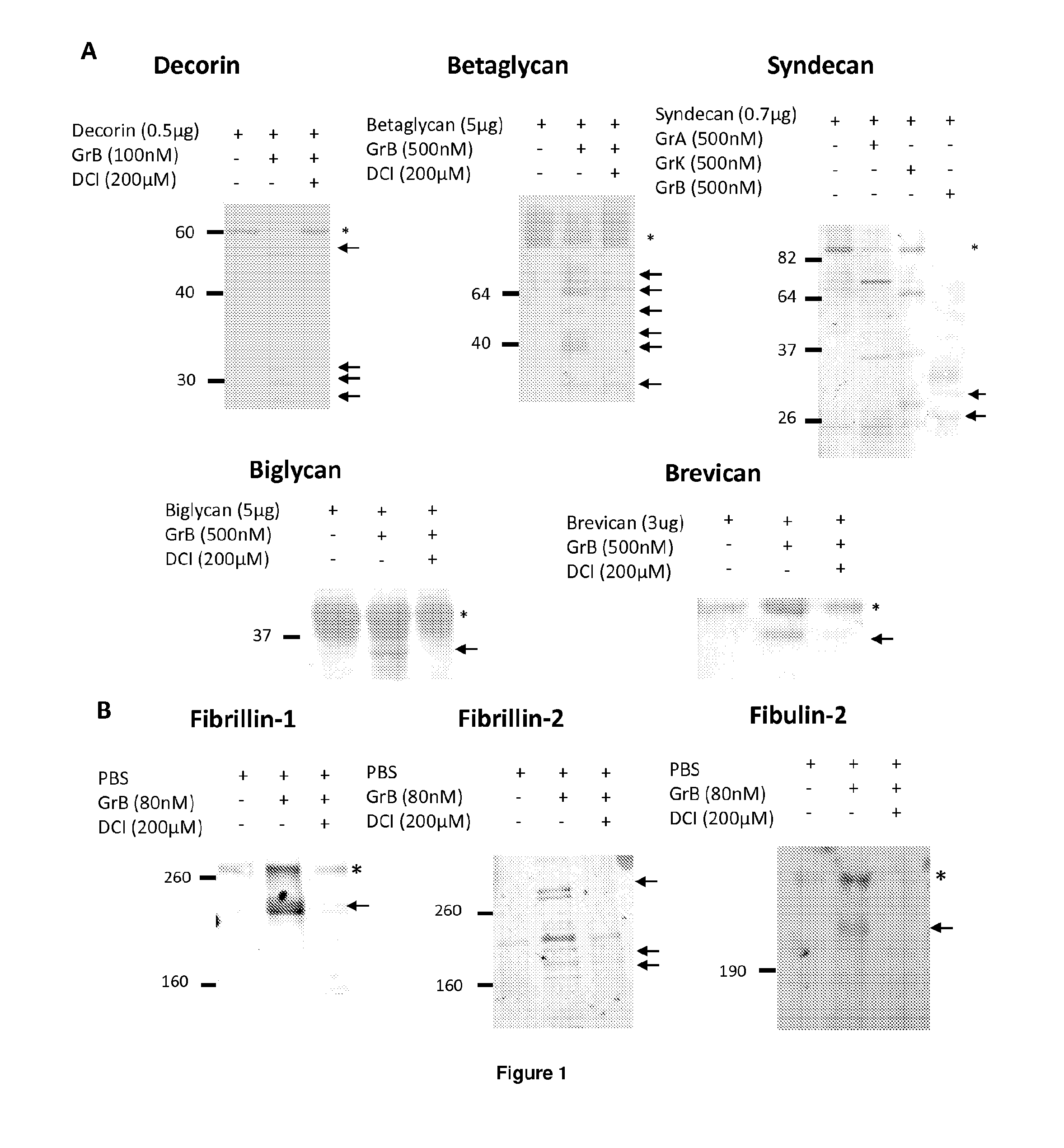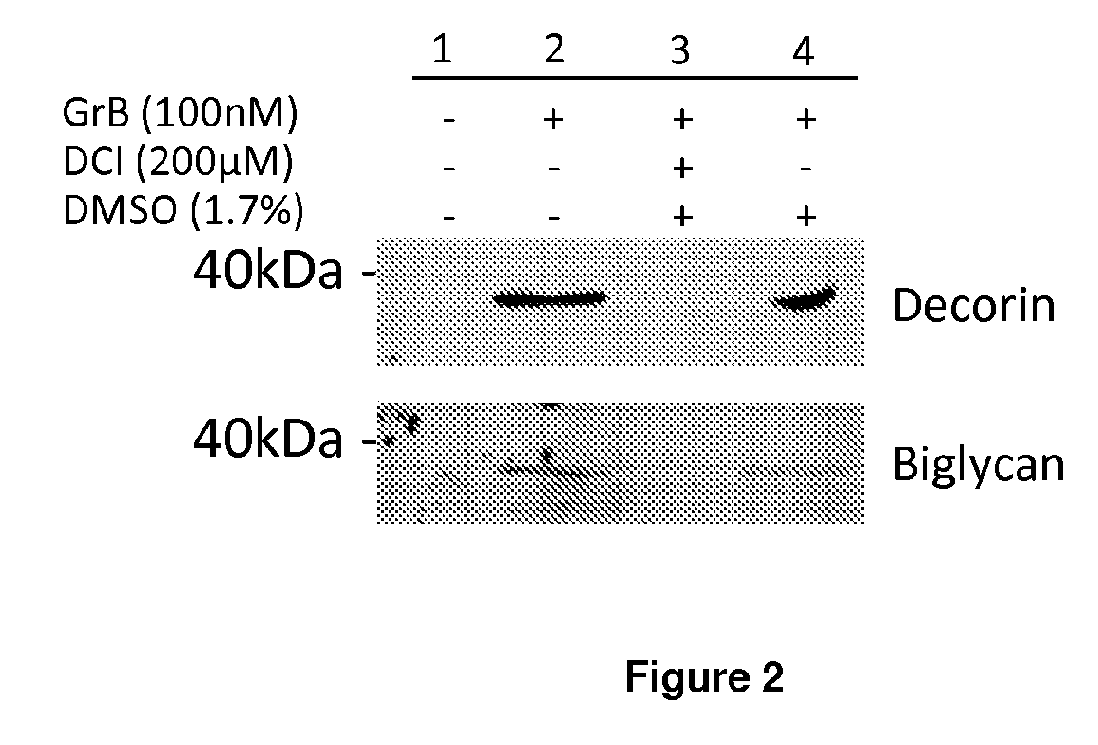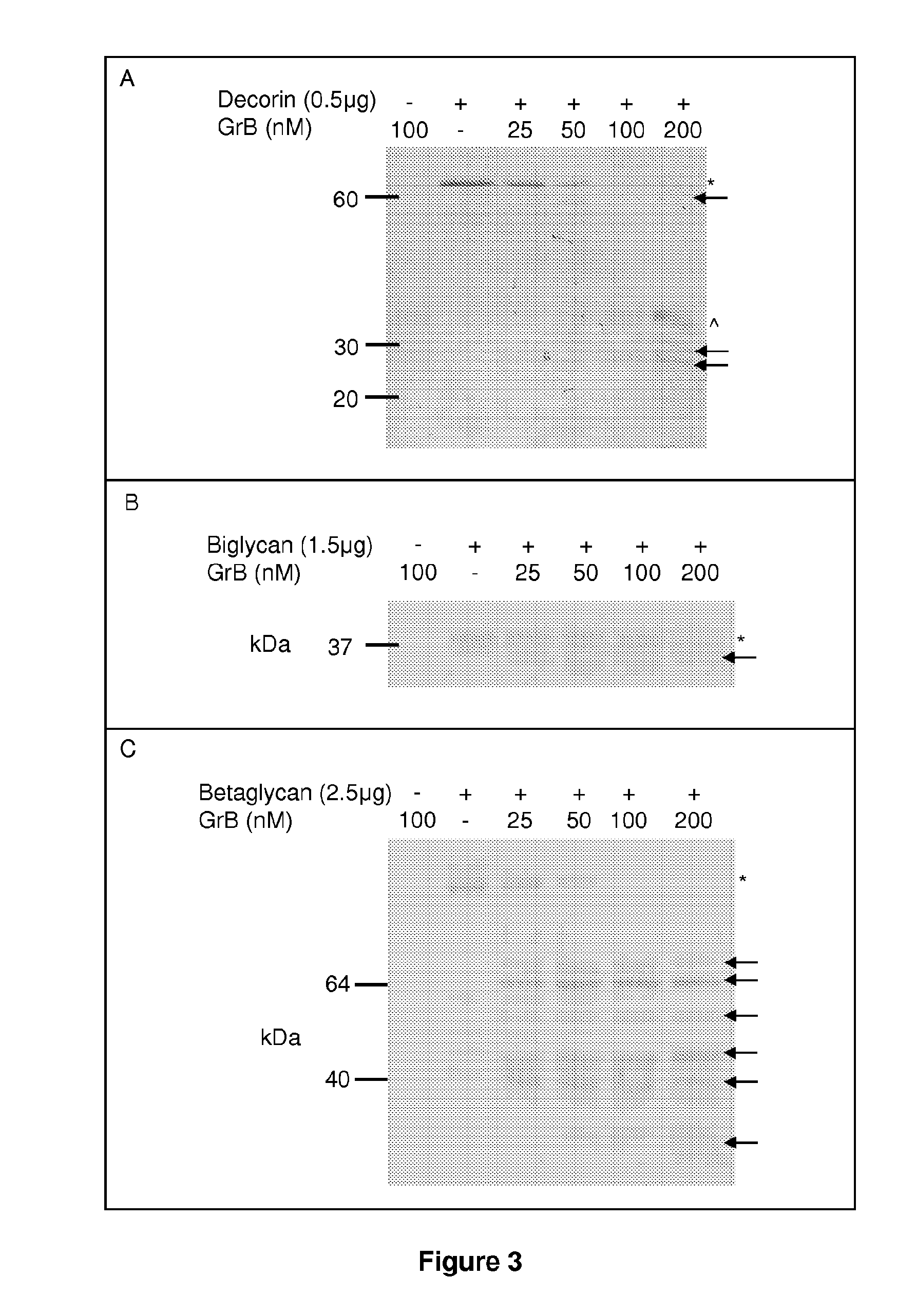Granzyme b inhibitor compositions, methods and uses for promoting wound healing
a technology of granule b and composition, applied in the direction of chemical treatment enzyme inactivation, peptide/protein ingredients, dna/rna fragmentation, etc., can solve the problems of skin's protective barrier being disrupted, weakened and/or ultimately broken, and thinning, so as to delay the onset of skin frailty, promote wound healing, and increase dermal thickness
- Summary
- Abstract
- Description
- Claims
- Application Information
AI Technical Summary
Benefits of technology
Problems solved by technology
Method used
Image
Examples
example 1
Granzyme B Cleaves Extracellular Matrix Proteins
[0425]Methods. For in vitro extracellular matrix cleavage assays, cells were grown to confluency and lysed, leaving the intact ECM on the plate. ECM was then biotinylated. Plates were then washed with PBS and incubated at 37° C. with Granzyme B and / or with the Granzyme B inhibitor, 3,4-dichloroisocoumarin (DCI), for 4 and 24 hours at room temperature. Supernatant was then collected and assessed for cleavage fragments. Fragments were determined by Western blotting or N-terminal sequencing. Confirmation of cleavage was performed subsequently with purified substrate.
[0426]Results: In order to identify extracellular Granzyme B substrates, recombinant decorin, biglycan, betaglycan, syndecan, and brevican were incubated with purified Granzyme B for 24 hours. Reactions were stopped with SDS-PAGE loading buffer, run on an SDS-PAGE gel and imaged by Ponceau staining of a nitrocellulose membrane. As shown in FIG. 1A, Granzyme B cleaves recombina...
example 2
Granzyme B Cleaves Proteoglycans and Releases Sequestered TGF-β from Extracellular Matrix
[0429]Methods:
[0430]For ECM cleavage assays, Granzyme B and / or the inhibitor 3,4-dichloroisocoumarin (DCI), were incubated for 4 and 24 hours at room temperature, with decorin, biglycan or soluble betaglycan and visualized by Ponceau staining. Cleavage fragments were subjected to Edman degradation for cleavage site identification.
[0431]As TGF-β is sequestered by the aforementioned proteoglycans, Granzyme B was incubated with TGF-β bound proteoglycans to determine if Granzyme B cleavage resulted in the release of sequestered TGF-β. Cytokine release was assessed in supernatants using Western blotting.
[0432]To determine if the TGF-β released by Granzyme B was active, supernatants from the above release assay were incubated on human coronary artery smooth muscle cells (HCASMC) and SMAD / Erk activation was examined by Western blotting.
[0433]Results:
[0434]Granzyme B cleaved decorin, biglycan and betagl...
example 3
Granzyme B Cleaves Decorin, Biglycan and Soluble Betaglycan and Releases Active Transforming Growth Factor-β
[0436]Methods:
[0437]Proteoglycan cleavage assays. The recombinant human PGs, decorin (0.5 μg, Abnova, Walnut, Calif.), biglycan and betaglycan (1.5-5 ug, R&D Systems, Minneapolis, Minn.) were incubated at room temperature for 24 h with 25-500 nM purified human Granzyme B (Axxora, San Diego, Calif.), in 50 mM Tris buffer, pH 7.4. For inhibitor studies, Granzyme B was incubated in the presence or absence of 200 μM of the serine protease inhibitor 3,4-dichloroisocoumarin (DCI; Santa Cruz Biotechnology Inc, Santa Cruz, Calif.) or inhibitor solvent control, dimethyl sulfoxide (DMSO; Sigma-Aldrich, St Louis, Mo.) for 4 h or 24 h. After incubation, proteins were denatured, separated on a 10% SDS-polyacrylamide gel and transferred to a nitrocellulose membrane. Ponceau stain (Fisher Scientific, Waltham, Mass.) was used to detect cleavage fragments.
[0438]N-Terminal Sequencing.
[0439]For ...
PUM
| Property | Measurement | Unit |
|---|---|---|
| temperature | aaaaa | aaaaa |
| time | aaaaa | aaaaa |
| MW | aaaaa | aaaaa |
Abstract
Description
Claims
Application Information
 Login to View More
Login to View More - R&D
- Intellectual Property
- Life Sciences
- Materials
- Tech Scout
- Unparalleled Data Quality
- Higher Quality Content
- 60% Fewer Hallucinations
Browse by: Latest US Patents, China's latest patents, Technical Efficacy Thesaurus, Application Domain, Technology Topic, Popular Technical Reports.
© 2025 PatSnap. All rights reserved.Legal|Privacy policy|Modern Slavery Act Transparency Statement|Sitemap|About US| Contact US: help@patsnap.com



